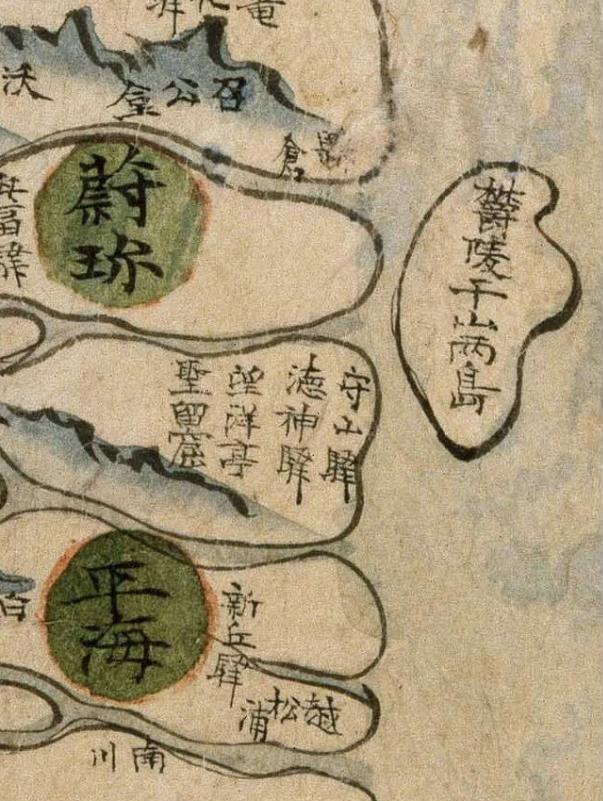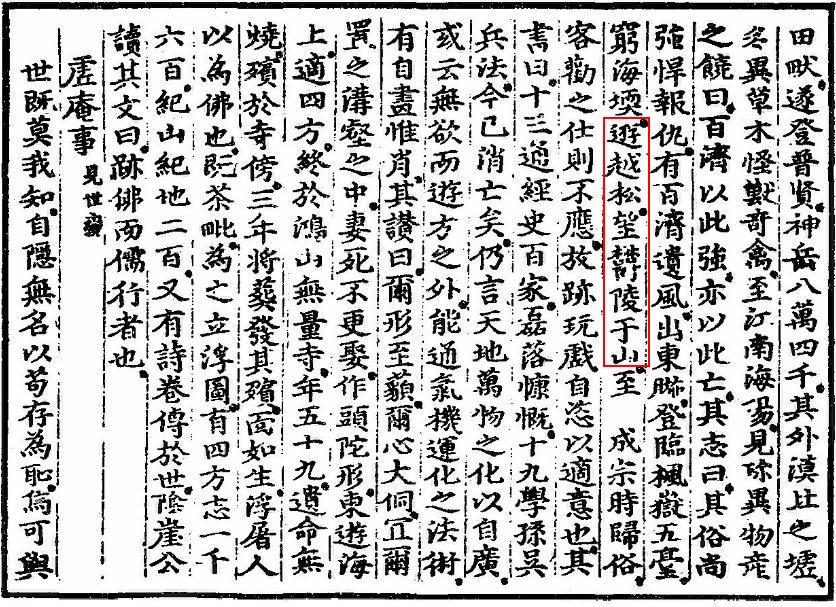 Heo Mok (許穆 - 허목) was a famous Korean scholar and government official who lived from 1595 to 1682. (See the picture to the left.) His pen name was Misu (眉叟), but he was also called "the old man of Tae-ryeong" (台嶺老人). Among the government offices he held was the Dohobusa (都護府使) of the Samcheok (三陟) region. Also, at the age of eighty-one, he was appointed as the U-euijeong (右議政), which was one of the highest positions in the Joseon government.
Heo Mok (許穆 - 허목) was a famous Korean scholar and government official who lived from 1595 to 1682. (See the picture to the left.) His pen name was Misu (眉叟), but he was also called "the old man of Tae-ryeong" (台嶺老人). Among the government offices he held was the Dohobusa (都護府使) of the Samcheok (三陟) region. Also, at the age of eighty-one, he was appointed as the U-euijeong (右議政), which was one of the highest positions in the Joseon government.Heo Mok was also well traveled and a fairly prolific writer. Among his works were the Cheokjuji (陟州誌) and Gi-eon (記言). The Gi-eon was a 67-volume set of writings on his studies of famous scholars and philosophers. One of the scholars written about in the Gi-eon was Kim Si-seup (金時習), who was a famous Korean scholar and government official who lived from 1435 to 1493.
According to the Gi-eon, Kim Si-seup could read by the time he was eight months old and could read and understand the Taehak (大學) and the Junyong (中庸) by the time he was five, which earned him the nickname "Ose-dongja" (五歲童子 - "the 5-year-old child"). He was so famous, in fact, that he got the attention of King Sejong (世宗), who sent a messenger with royal gifts and the message, "Raise him well because he will be of great service someday" (善養之 當大用也). By the time of King Munjong (文宗 : 1450 - 1452), Si-seup had already grown into a well-respected scholar with vast knowledge and extraordinary talent, but with the abdication of King Danjong (端宗) in 1455, Si-seup was forced to flee and begin a life as a wanderer. He took advantage of the situation, however, to visit many temples and famous places around the country. Among the famous places he visited was Weolsong Pavilion (越松亭), on the east coast of Korea, from which he viewed Ulleung/Usan. Here is the relevant passage:
登臨楓嶽五臺 窮海堧The above sentence is quite important in the Dokdo-Takeshima debate because, as you can see from the above quote, both Ulleungdo (鬱陵島) and Usando (于山島) were described as being visible from Weolsong (越松), which is on the east coast of Korea near Uljin. This quote is important because it is more evidence that the Usando in old Korean documents was not referring to Liancourt Rocks (Dokdo/Takeshima), which is much too far away to be viewed from the east coast of Korea. It is also evidence that the phrase "Ulleung/Usan" (鬱陵于山) was used to refer to the two islands as an "island group." In other words, the passage did not mean that both islands of Ulleungdo and Usando were seen from Weolsong, but that the Ulleung-Usan island group was seen.
He climbed (登臨) Mount Pung-ak (楓嶽) and Mount Odae (五臺), and the vast sea (窮海) was empty (堧).
遊越松望鬱陵于山
He traveled (遊) to Weolsong (越松) and viewed (望) Ulleung/Usan (鬱陵于山).
The Ulleung-Usan island group is also what was being referred to in the following passage from King Sejong's 1454 geography text, which was describing the county of Uljin (蔚珍) and its surrounding area:
于山武陵二島在縣正東海中 二島相去不遠 風日淸明 則可望見Korean historians try to claim that the distance mentioned in the above passage was referring to the distance between the two islands, not to the distance between Uljin and the two-island group, but since the passage was among others giving distances and bearings from Uljin to places in the surrounding area, we know that the distance referred to was the distance from Uljin to the Ulleungdo-Usando island group. In the case of Ulleungdo and Usando, the bearing was given as "in the sea due east of Uljin," and the distance was given as "the distance to the two islands is close enough that they are visible on clear days when the wind in blowing" (二島相去不遠 風日淸明 則可望見).
The two islands of Usan and Muleung (于山武陵二島) are in the sea due east of this village (在縣正東海中). The distance to the two islands is close enough (二島相去不遠) that they are visible on clear days when the wind is blowing (風日淸明 則可望見).
Korean maps even showed the two islands as an island group. For example, the following Korean map of Gangwon Province from the mid-1700s showed Ulleung/Usan (鬱陵于山) as one island off the east coast of Uljin (蔚珍), but it was labeled as 鬱陵于山兩島, which means "the two islands of Ulleung and Usan."

As you can see from the above, the "Ulleung/Usan" reference in Heo Mok's story about Kim Si-seup was consistent with other Korean documents and maps, which means that the Usando (于山島) mentioned in old Korean documents and maps was not a reference to Liancourt Rocks (Dokdo/Takeshima), but rather was just a reference to a neighboring island of Ulleungdo. The neighboring island was almost certainly Ulleungdo's neighboring island of Jukdo (竹島), which is about 2.2 kilometers off Ulleungdo's east shore. By the way, in the above map, you can see Port Weolsong (越松浦) just to the lower right of Pyeonghae (平海), which is the lower green circle. Weolsong (越松) was mentioned in Heo Mok's story as the place from which Kim Si-seup saw Ulleung/Usan (鬱陵于山) .
Below is a copy Heo Mok's story of Kim Si-seup, under the title of "Cheongsa Yeoljeon" (淸士列傳), from the 11th volume of the Gi-eon (記言). The passage that mentions Ulleungdo and Usando is outlined in red. (Click on the images to enlarge.)


記言卷之十一 中篇
淸士列傳
金時習者。本滄海人。生八月。能知書。五歲。通大學,中庸。長者師之。集賢學士崔致雲見之曰。奇才。乃命名時習。字悅卿。世宗聞之。欲召見之不可。令承政院召見之。厚賜其家曰。善養之。當大用也。於是四方號之曰。五歲童子。而不名也。至文宗時。時習稍長成。旣博達異能。名譽益多。及魯陵遜位。時習悉燒其書。因亡去。逃於浮屠。以絶跡於世也。楊州水落,壽春史呑,海上雪岳,寒溪,月城金鰲。皆時習樂居其間者也。自號贅世翁。或曰淸寒子。或曰東峯。時習早得大名。逢世故。一朝逃世絶俗。佯狂自隱。乖詭譎奇。以取怪而不悔也。以爲居治世。潔身亂倫。恥也。遇亂世。離群遠引。善也。慨然長往。行名山澤。遊摩阿岬。開京觀古國學。薩水問七翁仲。平壤觀井田畎。遂登普賢神岳八萬四千。其外漠北之墟多異草木怪獸奇禽。至江南海陽。見珍異物產之饒曰。百濟以此強。亦以此亡。其志曰。其俗尙強悍報仇。有百濟遺風。出東暆。登臨楓嶽,五臺。窮海堧。遊越松。望鬱陵,于山。至成宗時歸俗。客勸之仕。則不應放跡。玩戲自恣。以適意也。其書曰。十三。通經史百家。磊落慷慨。十九。學孫吳兵法。今已消亡矣。仍言天地萬物之化以自廣。或云無欲而遊方之外。能通氣機運化之法術。有自畫惟肖。其讚曰。爾形至藐。爾心大侗。宜爾置之溝壑之中。妻死不更娶。作頭陀形。東遊海上。適四方。終於鴻山無量寺。年五十九。遺命無燒。殯於寺傍。三年將葬。發其殯。面如生。浮屠人以爲佛也。旣茶毗。爲之立浮圖。有四方志一千六百。紀山紀地二百。又有詩卷。傳於世。陰崖公讀其文曰。跡佛而儒行者也。
Thank you, Gerry
ReplyDeleteThis is an interesting story.
So, the sentence was based on something which was written by Kim Si-seup between 1455-1493? This is just my guess, but Kim Si-seup could have read King Sejong's 1454 geography text ? I heard King Sejong's geography text itself is much less important compared to 高麗史地理 and 東国輿地勝覧. Is that so?
Kaneganese,
ReplyDeleteI am not sure where Heo Mok got all the information on Kim Si-seup, but the story quoted, at least, one sentence from one of Kim Si-seup's letters.
I hadn't heard the 高麗史地理 and 東国輿地勝覧 were more important, but they essentially say the same thing. For example, here is the sentence from the The History of Koryo:
一云 于山·武陵 本二島 相距不遠 風日淸明 則可望見
Also called Usan/Muleung (一云 于山·武陵), the two islands (本二島) are close enough (相距不遠) that they are visible on clear, windy days (風日淸明 則可望見).